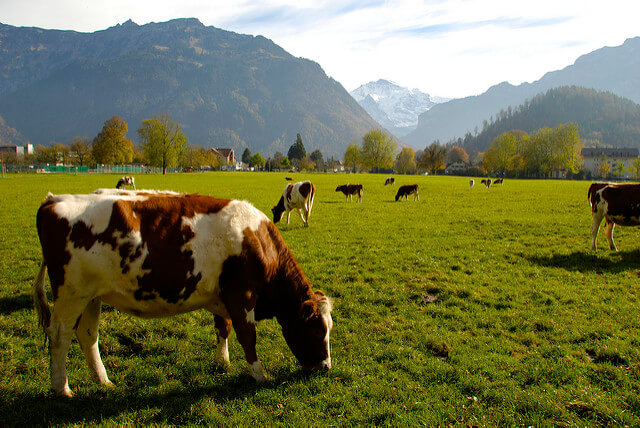Considering the trade-offs between best environmental practices and the climate impact of agriculture

In Innovation Spotlight, we explore some of the most promising innovations from around our community. This week, we take a look at Manuel Klarmann, Founder and CEO of Eaternity, to find out more about the Eaternity journey through the organic farming debate.
Food production from farm to fork accounts for almost a third of Europe’s greenhouse gas emissions. Reducing the environmental impacts of agriculture requires a transition towards innovative, low-input systems.
Organic production is increasingly playing a role in nutrient management and reducing pesticide use, while organic produce is an increasingly popular health choice. Organic farming aims for a combination of environmental practices — biodiversity protection, natural resources preservation, animal welfare standards, omission of synthetic chemical inputs and genetically modified organisms. Climate impact, however, is still not fully integrated. While organic vegetables can strike a balance between environmental standards and reduce emissions, organic meat represents an area where trade-offs must be made.
Such has been the subject of investigation for Eaternity, a Swiss company, and Climate KIC partner which offers catering clients and restaurants software to help calculate the carbon footprint of the meals they serve and make better environmental choices. We spoke to Manuel Klarmann, Founder and CEO of Eaternity, to find out more about the Eaternity journey through this debate.
You’ve recently done research into how to gauge the environmental and climate impact of organic produce, as well as how national organic labels differ in regulation and whether this influences the carbon footprint of their products. What were your main findings?
Organic food production is often brought up as a solution when we talk about sustainable food production. However, climate measures are not explicitly part of organic regulations. We wanted to investigate if the environmental benefits hold up for climate as well. Our findings show that simply buying organic food — especially meat — does not save us from climate change.
There are lots of common denominators between organic agriculture and climate impact. Organic vegetables are in certain cases clearly better for the climate. In Switzerland, for example, there are regulations (BioSuisse) around peat, which is not allowed to be used to produce organic food. There are also regulations that restrict heating to promote growth of vegetables in greenhouses. Organic labels and institutions evolved around a certain idea, a certain business model, and certain economics for meat production. It’s highly political, and they have a hard time bringing up the climate topic, because this is the main thing that farmers are standing on – selling cattle and making money.
We need to find new and more elaborate ways to reduce the animal farming impact of this cycle, to actually reduce the effects on climate. It’s tough. It is certain that we have to reconnect with our food source and make educated food choices. We also might need a revolution of the organic standards.
So how exactly do you see this trade-off?
For example, the more space you give an animal to graze, to be outside, to be happy, to be ethically produced, the longer it will take for an animal to gain a certain weight. The longer this process takes, the more methane it will emit and the more feed it needs to gain weight. If we try to maximise the ethical aspect and the organic aspect of cattle farming, more impact this will have on climate. This conflict was found for beef and chicken in Switzerland but not for pork.
You also calculated the carbon footprint of European’s organic greenhouse produce. Can you tell us a bit more about that?
With our greenhouse model we looked at different countries, and how much sunlight these countries receive. Then we looked at crops grown in greenhouses, and how much sun they need to mature based on the season. Based on that we determine the energy needed to grow the vegetable in a greenhouse. Based on these factors, we have a model that makes it possible for us to calculate how much carbon dioxide is emitted to grow the vegetable at a certain time. So this gives us a good estimate of when it’s best to buy what produce.
How are you going to integrate these findings into your work with catering and restaurants?
We will take all this knowledge, and package it conveniently into one product, so restaurant operators can use the information at hand to measure and improve their impact on the climate. The new software has three pillars, with indicators on health, climate, and environmental impacts such as water scarcity, deforestation, as well as animal welfare.
We offer a monthly report based on all the supply purchases of a restaurant, as well as live calculation of recipes through the interface of a software where the chef does the menu and recipe planning, and they get live feedback on their impact. There will also be new software which makes it possible for consumers and restaurants more easily to do these calculations on their own. We will release the software later this year.
How are you planning to disseminate your findings?
In September 2017, we are holding an event to introduce the research that addresses the organic and health aspects of food on the climate. All of these indicators will be used in our software to calculate them over thousands of meals and we will publish these results. The idea is to formulate a message for the food service industry that can be used by established organisations in the field of organic agriculture. We’re looking to jointly do something for sustainability. Organic agriculture is really important, and we want to help include the environment and climate change into the equation.
